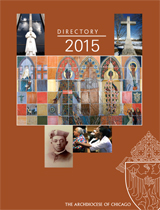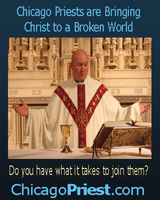Conference: All liturgy should be directed to God
The best liturgy is one where every aspect is directed toward God, according to speakers at an Oct. 5 and 6 conference at the Liturgical Institute at University of St. Mary of the Lake/Mundelein Seminary.
“Ten Things Your Parish Needs to Know About the Liturgy” spoke to lovers of the Catholic liturgy through 10 talks and a keynote speech touching on different aspects of the liturgy.
“The liturgy fosters our beliefs, nourishes our faith, and sends us out into to our homes and to the world,” said Father Douglas Martis, director of the Liturgical Institute of the University of Saint Mary of the Lake. “If we did a better job praying, the world would be a better place. The impact of our prayer would spill into our everyday lives and those around us.”
The keynote speaker, Father Robert Barron, echoed St. Thomas Aquinas’ description of liturgy as “an act of justice.” Barron, professor of systematic theology at the university, is an author and speaker heard regularly on Relevant Radio for his “Word on Fire” program of Catholic evangelical preaching. Cardinal Francis George recently appointed Barron to head the Archdiocese’s evangelization mission.
“Justice is rendering to each what is due,” Barron said “And what is due to God? Everything. All our praise and thanksgiving.” Barron explained that this praise is not given because God needs it, but because we do. “By praising God, our personality comes together in right order—or to bring it to a higher level, all the tribes of the world come together in harmony.”
Barron defines this harmonious relationship with God as adoration or “adoracio.” The etymology of the word, he said, is “mouth to mouth. When God first created Adam, they walked through Eden side by side. Adam was at ease, in line with God, properly ordered.” The rest of the Bible is the continual disordering of this relationship by man and the consistent rescue by God, Barron said.
“Liturgy is the act by which the order desired by God and interrupted by sin is restored,” Barron said. “Our role is to bring adoracio out into the world.”
That, he said, is what St. Thomas was describing when he said that liturgy is an act of justice.
Each speaker explained how the liturgy is designed to direct attention to this ordered relationship with God. Sister Marganne Drago, a Sister of St. Joseph from Philadelphia, spoke on the topic, “Don’t Sing At Mass; Sing the Mass.” People sing—whether in the shower, on stage, or in church—because it is their own personal instrument, she said.
“At Mass we are using this instrument to do something that is directed totally toward God,” Drago said.
Quality, she said, has nothing to do with this. “If we start worrying that we are not good enough singers, we are directing our focus back to ourselves. Everything we do should point to God.”
Denis McNamara, assistant director of the Liturgical Institute, is an author and teacher on liturgical art and architecture. In his talk about “How to Read a Church Building,” McNamara said that “the church building and its liturgy are sacraments of the Fall (of man) undone.”
Remembering that a sacrament is a material manifestation of an invisible theological reality, he described how the sounds, smells, feelings, sights, and tastes are related to order, beauty and harmony that God wants in relationship with us.
Through a detailed description of a variety of architectural aspects of churches, McNamara showed us their “deep designs,” rich in Biblical meaning.
“Pope John Paul II said that beauty is the splendor of the church,” he said, explaining that the more we are attuned to God, the more open we are to reaching his truth.
Father John Szymd, faculty member and director of liturgy for Mundelein Seminary, spoke about the rich flow between the celebration of the Eucharist and the Liturgy of the Hours.
“The Liturgy of the Hours brings the sacredness of time and history into the entire day,” he said. The challenge is to foster an awareness of sacred time, which is the purpose of a progressive solemnity in liturgies, he added. By varying which prayers are sung, when incense is used, the processions into and out of church, and other variables, a parish can learn to distinguish the solemnity of each day—whether it is a weekday Mass, a Sunday in Ordinary Time, a saint’s feast day, or Easter Sunday.
Other speakers during the two-day conference included James Pauley, assistant professor of theology and catechetics at Franciscan University in Steubenville, Ohio; Father Thomas Milota, pastor of Saints Peter and Paul in Naperville, Ill.; Sheila Liaugminas, an Emmy Award winning journalist with extensive experience in secular and religious journalism; Father Peter Girard, a Dominican friar currently teaching at Holy Apostles Seminary in Cromwell, Conn.; Father Dennis Gill, a doctoral candidate in liturgy at the Pontifical Liturgical Institute Sant’Anselmo in Rome; Christopher Carstens, director of the Office of Sacred Worship in the Diocese of LaCrosse, Wis., as well as a lecturer and adjunct faculty member of the Liturgical Institute.
There were, of course, ten topics that the 60 or more attendees learned about to bring back to their parishes. In addition to the subjects already discussed, speakers presented the importance of participation in liturgy, the Eucharist as both a meal and a sacrifice, the liturgy as the ritual expression of what we believe, liturgy as a means of sharing church documents, and liturgy as a means of catechesis.
 Catholic
New World - Newspaper for the Archdiocese of Chicago
Catholic
New World - Newspaper for the Archdiocese of Chicago Archdiocese of Chicago Directory
Archdiocese of Chicago Directory Oficjalne wydawnictwo Archidiecezji Chicago w języku polskim
Oficjalne wydawnictwo Archidiecezji Chicago w języku polskim